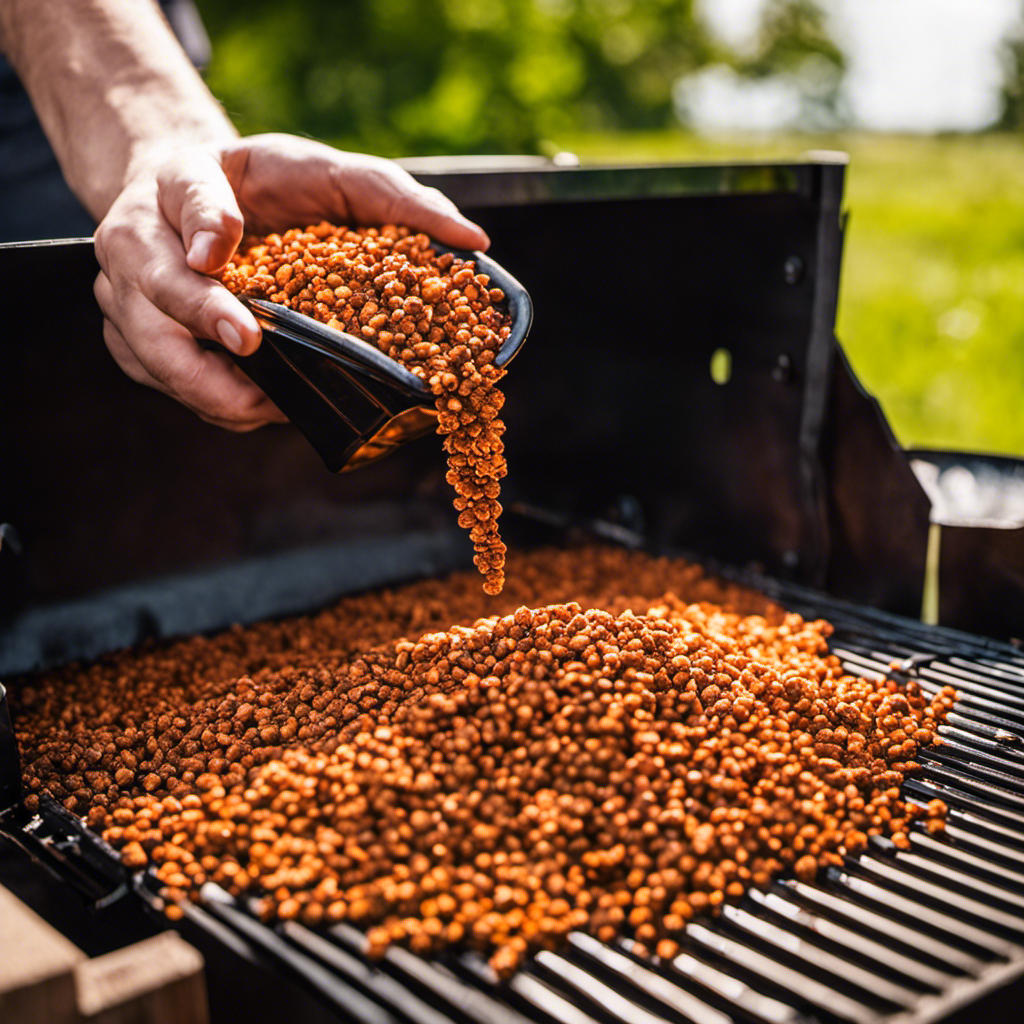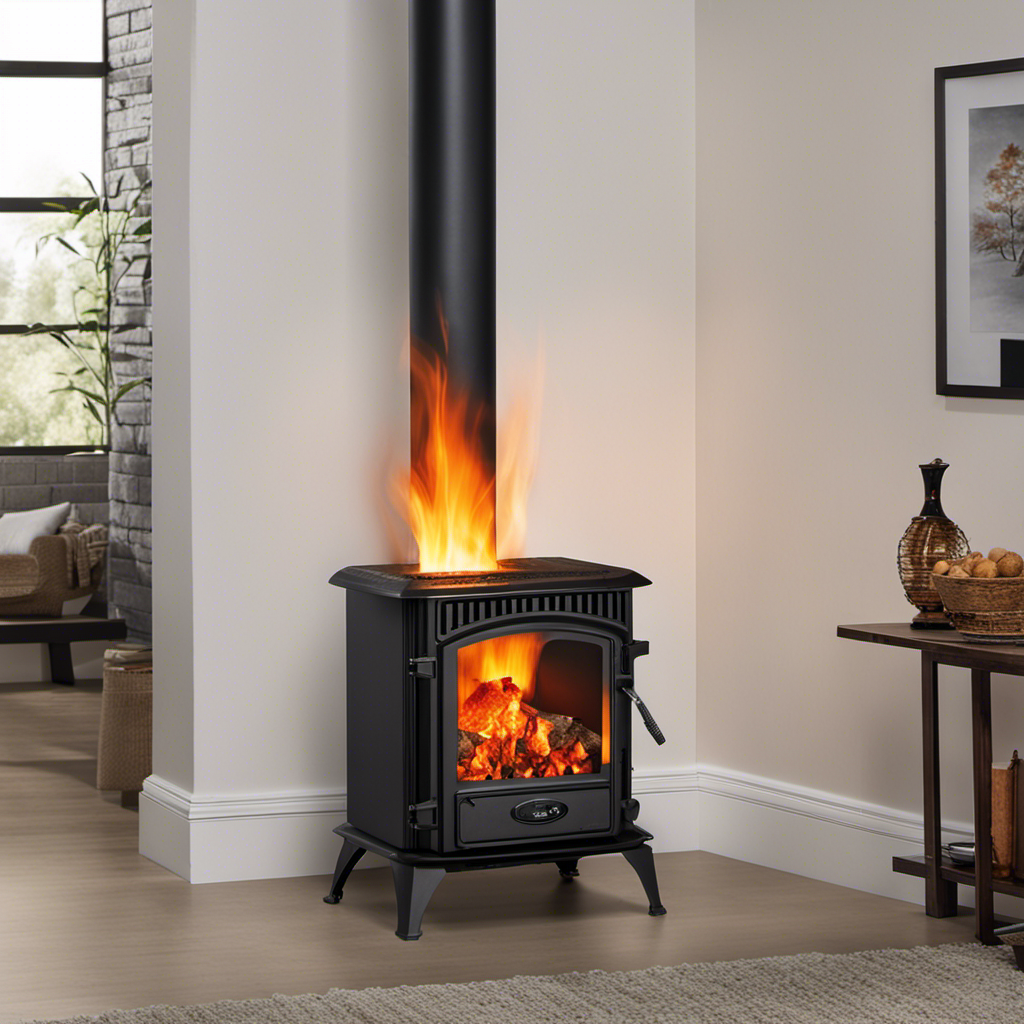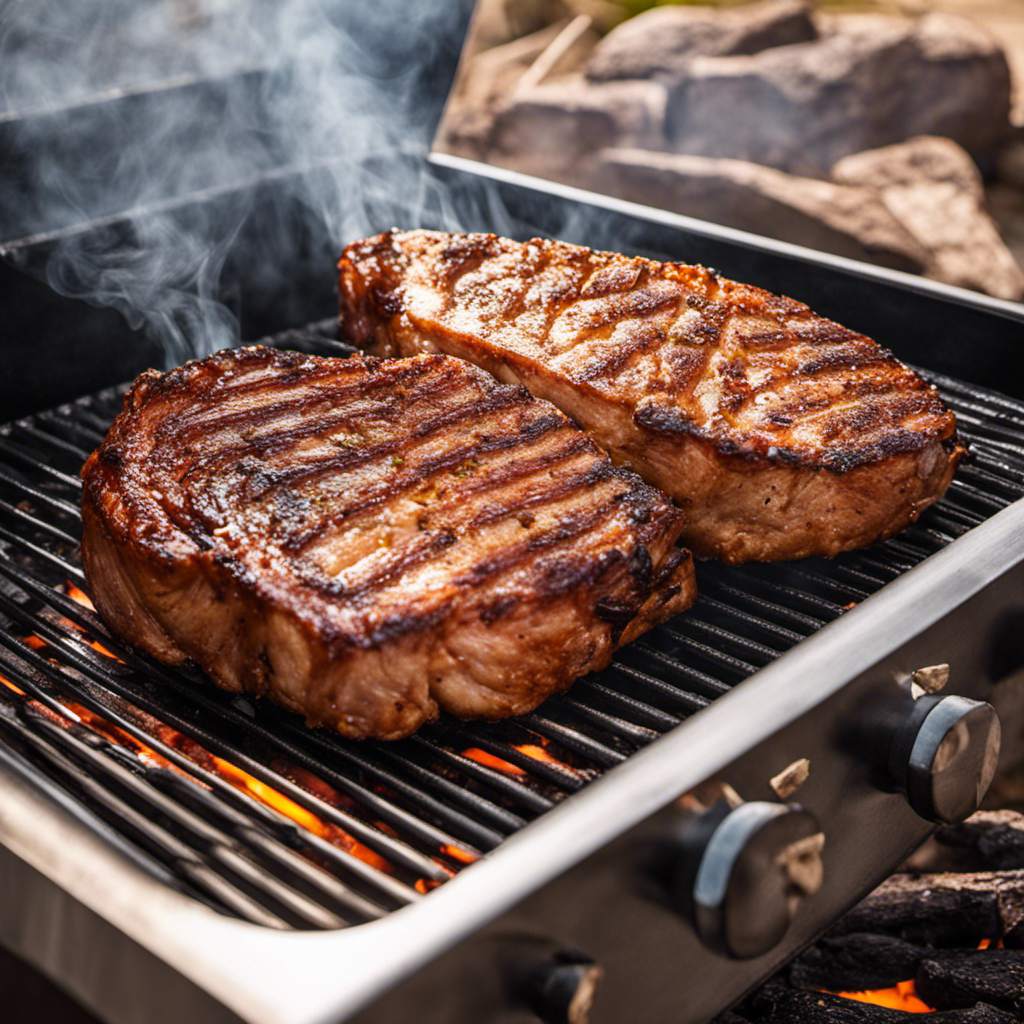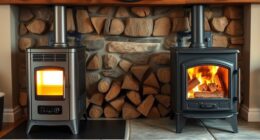How long will a wood pellet stove burn? Does it provide sustained heat and comfort, or will I need to regularly tend to and adjust it? Such questions are common among homeowners considering a wood pellet stove for heating.
In this article, I will explore the various factors that affect burn time, the types of wood pellet stoves available, and provide tips on how to extend burn time. By the end, you’ll have a better understanding of the burn time capabilities of wood pellet stoves and how to maximize their efficiency.
Key Takeaways
- Fuel moisture content affects burn efficiency and duration
- Pellet size impacts burn time, with smaller pellets burning faster
- The type and quality of wood pellets used affect burn time and heat output
- Regular stove cleaning and maintenance are crucial for optimal burn time and efficiency
Factors Affecting Burn Time
There are several factors that can affect how long a wood pellet stove burns. Two important factors to consider are the fuel moisture and the pellet size.
The fuel moisture refers to the amount of water content in the pellets. Pellets with higher moisture content will burn less efficiently and produce less heat, resulting in a shorter burn time. On the other hand, pellets with lower moisture content will burn more efficiently and provide a longer burn time.
Additionally, the size of the pellets can also impact burn time. Smaller pellets tend to burn faster, while larger pellets burn slower and last longer.
By understanding the importance of fuel moisture and pellet size, you can optimize the burn time of your wood pellet stove.
Moving on to the types of wood pellet stoves…
Types of Wood Pellet Stoves
When choosing a wood pellet stove, it’s important to select the right one that suits your needs and preferences. You’ll find various types available on the market, including freestanding, insert, and fireplace insert pellet stoves.
Freestanding stoves are versatile and can be placed anywhere in your home, while insert stoves are designed to fit into existing fireplaces. Fireplace insert stoves provide a cozy ambiance and are perfect for those who want to convert their traditional fireplace to a more efficient heating system.
Regardless of the type, wood pellet stoves offer numerous benefits, such as cost savings, eco-friendliness, and convenience. To maximize the efficiency of your wood pellet stove, it’s important to choose the best wood pellets available, as they can significantly impact the burn time and heat output.
Speaking of burn time, let’s now explore the average burn time for different models.
Average Burn Time for Different Models
To get the most out of your wood pellets, you’ll want to know the average burn time for different models. This knowledge will help you determine how long you can expect your wood pellet stove to provide heat before needing to refill it. When comparing burn time, there are several factors that can affect efficiency. Here are four key considerations:
- Pellet quality: Higher quality pellets tend to burn longer and produce more heat.
- Stove size: Larger stoves generally have a larger hopper capacity, allowing for longer burn times.
- Heat output: Stoves with higher heat output may burn through pellets faster but provide more warmth in a shorter time.
- Burn rate control: Stoves with adjustable burn rates can help you extend burn time by allowing you to control the amount of fuel consumed.
Understanding these factors will help you make an informed decision when choosing a wood pellet stove.
Now, let’s delve into some tips for extending burn time without compromising efficiency.
Tips for Extending Burn Time
If you want to maximize the duration of your wood pellet stove’s heat output, consider implementing these tips for extending burn time. By following these strategies, you can make the most out of your wood pellets and increase the efficiency of your stove. Here are some key tips:
| Tips for Extending Burn Time | Explanation |
|---|---|
| Clean the stove regularly | Regular cleaning helps maintain optimal airflow, resulting in a more efficient burn and longer heat output. |
| Use high-quality pellets | High-quality pellets burn more efficiently and produce more heat, allowing for a longer burn time. |
| Adjust the air intake | Properly adjusting the air intake controls the burn rate, helping to extend the burn time. |
| Load the stove correctly | Properly loading the stove with pellets ensures even combustion and maximizes heat output. |
| Optimize insulation | Good insulation minimizes heat loss and helps retain the generated heat for a longer duration. |
Best Practices for Loading Wood Pellets
One of the best ways to maximize the efficiency of your wood pellet stove is by following these best practices for loading the pellets. Proper loading techniques can make a significant difference in how long your stove burns and how effectively it heats your home.
When loading the pellets, it is important to avoid overfilling the hopper, as this can lead to poor combustion and decreased burn time. Additionally, make sure to distribute the pellets evenly across the burn pot to ensure consistent heat output.
Troubleshooting common issues during the loading process includes checking for any blockages or debris that may hinder the flow of pellets into the burn pot.
By following these loading techniques and addressing any common issues, you can optimize the performance of your wood pellet stove.
Now, let’s explore how to adjust the air flow for longer burn time without compromising efficiency.
How to Adjust Air Flow for Longer Burn Time
To achieve a longer burn time while maintaining efficiency, you should adjust the air flow in your wood pellet stove. By adjusting the air flow, you can regulate the burn rate of the pellets, ensuring a steady and consistent heat output.
To start, locate the air intake and exhaust vents on your stove. These vents control the amount of oxygen coming into the stove and the amount of exhaust gas leaving it. If you notice that your pellets are burning too quickly, causing the stove to run out of fuel faster than expected, you can try closing the air intake slightly to reduce the amount of oxygen. On the other hand, if your pellets are burning too slowly, you can open the air intake to allow more oxygen in.
Troubleshooting the air flow in your wood pellet stove is crucial for achieving optimal burn time and efficiency.
Now that you know how to adjust the air flow to achieve a longer burn time, it is important to understand the importance of proper maintenance for maintaining this extended burn time.
Importance of Proper Maintenance for Burn Time
When it comes to maintaining a wood pellet stove for optimal burn time, there are a few key points to consider.
Firstly, proper cleaning of the stove is essential for efficient operation and prolonged burn time. This includes removing ash buildup and cleaning the flue.
Secondly, using high-quality fuel pellets is important. This ensures consistent heat output and prevents clogs or malfunctions in the stove.
Lastly, storing the fuel pellets in a dry and clean environment is crucial. This helps maintain their quality and prevents any issues that may arise from moisture or dirt.
Cleaning and Efficiency
You can improve the efficiency of your wood pellet stove by regularly cleaning the ash and maintaining proper air flow. Cleaning frequency plays a crucial role in keeping your stove running smoothly. Here are some key points to consider:
- Cleaning frequency:
- Regularly clean the ash pan to prevent build-up and ensure proper airflow.
- Clean the glass door of the stove regularly to maintain visibility and aesthetics.
Using the right cleaning tools is essential for effective maintenance:
- Cleaning tools:
- Use a specialized ash vacuum or a scoop and brush set to remove ash.
- Opt for a non-abrasive glass cleaner and a soft cloth for cleaning the glass door.
By following these cleaning practices, you can maximize the efficiency and performance of your wood pellet stove.
Now, let’s explore the next aspect of maintaining a wood pellet stove: fuel quality and storage.
Fuel Quality and Storage
Proper fuel storage is crucial for maintaining the quality and performance of your wood pellets. Ensuring that your fuel remains in optimal condition will not only extend its burn time but also enhance the efficiency of your wood pellet stove.
To preserve fuel quality, it is important to store your pellets in a dry and well-ventilated area, away from moisture and extreme temperatures. Moisture can cause the pellets to deteriorate, leading to reduced burn time and increased ash content. Additionally, exposure to extreme temperatures can affect the density and energy content of the pellets.
By following proper storage practices, you can maximize the burn time and overall performance of your wood pellet stove.
Now, let’s delve into some common mistakes that can inadvertently reduce burn time.
Common Mistakes That Reduce Burn Time
Proper fuel storage is crucial for maximizing the burn time of a wood pellet stove. It is important to store pellets in a dry, cool area to prevent moisture absorption and degradation.
In addition to fuel storage, airflow and ventilation are key factors to consider. Ensuring adequate airflow and ventilation within the stove and its surroundings helps to maintain optimal combustion and prevent the accumulation of ash and debris.
Regular maintenance and cleaning are also essential for prolonging burn time and ensuring efficient operation. This includes removing ashes and inspecting the stove components.
Proper Fuel Storage
To ensure a longer burn time, make sure to store your wood pellets in a dry and cool area. Proper fuel storage is crucial for maintaining the quality and burn duration of your wood pellets. Moisture and temperature fluctuations can negatively impact the pellets, leading to reduced burn time and inefficient heating. I recommend storing the pellets in airtight containers or bags to prevent moisture absorption. Additionally, it is important to keep the pellets away from direct sunlight and extreme temperatures, as this can cause degradation of the pellets. Here is a table summarizing the best practices for fuel storage:
| Storage Tips |
|---|
| Keep pellets dry |
| Store in a cool area |
| Use airtight containers |
| Avoid direct sunlight |
| Protect from extreme temperatures |
Now, let’s move on to the next section about airflow and ventilation without losing the momentum of maintaining an efficient burn.
Airflow and Ventilation
When it comes to wood pellet stoves, proper airflow and ventilation are crucial for optimal performance. Ensuring the right amount of air is reaching the combustion chamber is essential for efficient burning and heat output. Airflow optimization can be achieved by adjusting the air intake and exhaust vents to allow for the right balance of oxygen and fuel.
Additionally, weather conditions can impact the stove’s performance. Cold temperatures may affect the draft, while high humidity can lead to poor combustion. To tackle these challenges, it is important to consider installing a damper to regulate airflow and a draft inducer to enhance ventilation.
By maintaining proper airflow and ventilation, you can maximize the burn time and heat output of your wood pellet stove.
Transitioning into the subsequent section about ‘maintenance and cleaning’, it is important to keep your wood pellet stove in optimal condition to ensure its longevity and efficiency.
Maintenance and Cleaning
Regular maintenance and cleaning of your wood pellet stove is essential to ensure its longevity and efficient performance. To maintain optimal functionality, it is recommended to clean your wood pellet stove at least once a month or more frequently if you use it daily. This cleaning frequency helps prevent the buildup of ash and soot, which can affect the stove’s efficiency and lifespan.
When cleaning your wood pellet stove, it is important to use the right products. Dry cleaning methods, such as using a brush or vacuum, are ideal for removing loose debris and ash. For more stubborn residue, mild soaps or specialized stove cleaners can be used.
By following these cleaning practices, you can ensure your wood pellet stove operates effectively for years to come.
Now, let’s delve into comparing burn time between wood pellet stoves and other heating methods.
Comparing Burn Time Between Wood Pellet Stoves and Other Heating Methods
If you’re comparing burn times, wood pellet stoves tend to burn longer than other heating methods. This is due to the efficient combustion process and the high energy density of wood pellets. Here are four benefits of wood pellet stoves in terms of burn time comparison:
-
Extended burn time: Wood pellet stoves can burn for up to 24 hours on a single load of pellets, providing consistent heat without the need for constant refueling.
-
Less maintenance: With longer burn times, wood pellet stoves require less attention and maintenance compared to other heating methods, saving you time and effort.
-
Cost-effective: Longer burn times mean you’ll use fewer pellets, resulting in cost savings over time.
-
Environmentally friendly: Wood pellets are a renewable energy source made from compressed sawdust and other wood waste, making wood pellet stoves a sustainable heating option.
Understanding the energy efficiency ratings for wood pellet stoves is crucial to maximizing their performance and reducing energy consumption.
Understanding Energy Efficiency Ratings for Wood Pellet Stoves
When it comes to wood pellet stoves, understanding energy efficiency ratings is crucial. These ratings indicate how effectively the stove converts fuel into usable heat.
Factors such as the stove’s design, combustion technology, and insulation all play a role in determining its efficiency.
Rating Importance for Stoves
To properly assess the quality of wood pellet stoves, it is important to consider the importance of ratings and how they can guide your decision-making process. Ratings provide valuable information about the fuel efficiency and cost comparison of different models. Here are three key reasons why ratings are crucial:
-
Energy Efficiency: Ratings indicate how efficiently a stove converts fuel into heat, allowing you to calculate potential savings on your energy bills.
-
Cost Comparison: Ratings help you compare the long-term costs of different stoves, considering factors like fuel consumption and maintenance requirements.
-
Environmental Impact: Ratings also consider the environmental impact of a stove, such as emissions and sustainability of the fuel source.
Understanding these ratings is essential for making an informed decision about which wood pellet stove to purchase.
Now, let’s delve into the factors affecting efficiency and performance.
Factors Affecting Efficiency
One important factor that affects efficiency is the type of fuel used in the stove. The choice of fuel can have a significant impact on the stove’s performance. Wood pellets, for example, are a popular fuel choice for stoves due to their high energy content and low moisture content. This allows for more efficient combustion and longer burn times.
Other factors that can affect performance include the stove’s insulation. Proper insulation helps to retain heat within the stove, maximizing heat output and minimizing heat loss. Insulation materials such as firebricks and ceramic fibers are commonly used to improve the stove’s efficiency.
Additionally, factors such as the stove’s design, air intake, and maintenance can also play a role in its overall efficiency and performance.
Does the Type of Stove affect the Burning Time of Wood Pellets?
Yes, the type of stove does affect the burning time of wood pellets. A wood or pellet stove ifs designed to efficiently burn wood pellets, resulting in longer burning times. These stoves are designed with features that optimize the burning process, leading to more heat output for a longer period of time.
Frequently Asked Questions
How Long Do Wood Pellet Stoves Typically Last?
On average, wood pellet stoves last around 10-15 years with proper maintenance. Regular cleaning, ash removal, and professional servicing can extend their lifespan. It’s important to follow manufacturer guidelines to ensure optimal performance and longevity.
Can I Use Any Type of Wood Pellets in My Stove?
I can use both hardwood and softwood pellets in my stove, but there are pros and cons to consider. Hardwood pellets burn longer and produce more heat, while softwood pellets ignite faster. To optimize performance, I store my wood pellets in a dry, cool place.
Are Wood Pellet Stoves Easy to Clean and Maintain?
Cleaning and maintaining wood pellet stoves is crucial for optimal performance. Regularly emptying the ash pan, cleaning the glass, and inspecting the vents are key cleaning methods. Additionally, proper fuel storage and regular professional maintenance ensure longevity.
What Are the Benefits of Using a Wood Pellet Stove Over Other Heating Methods?
Using a wood pellet stove has many benefits over other heating methods. It is highly efficient, providing consistent heat and reducing energy costs. Additionally, it is environmentally friendly and easy to maintain.
Can I Use a Wood Pellet Stove as the Primary Heat Source for My Entire Home?
Using a wood pellet stove as my home’s primary heat source is efficient and cost-effective. It also has a positive environmental impact, making it a sustainable choice.
Conclusion
In conclusion, the burn time of a wood pellet stove can vary depending on various factors. These factors include the type of stove, the quality of wood pellets used, and how the stove is maintained. Some models may offer longer burn times than others. However, it is important to remember that proper loading techniques and maintenance play a crucial role in maximizing burn time.
Additionally, it is worth investigating the theory that wood pellet stoves have higher energy efficiency ratings compared to other heating methods. This could further enhance their appeal and effectiveness as a heating solution.
Growing up surrounded by the vast beauty of nature, Sierra was always drawn to the call of the wild. While others sought the comfort of the familiar, she ventured out, embracing the unpredictable and finding stories in the heartbeat of nature.
At the epicenter of every remarkable venture lies a dynamic team—a fusion of diverse talents, visions, and passions. The essence of Best Small Wood Stoves is crafted and refined by such a trio: Sierra, Logan, and Terra. Their collective expertise has transformed the platform into a leading authority on small wood stoves, radiating warmth and knowledge in equal measure.











